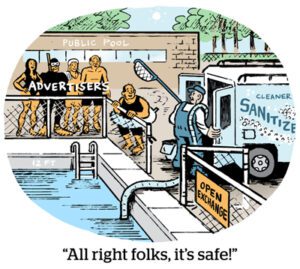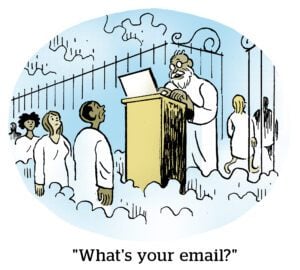Brand safety tech is blocking the news – and publishers are fed up.
But imploring advertisers to support the news for high-minded reasons like preserving democracy and access to information for all isn’t stopping blocklists from proliferating.
As a result, news organizations pay the price for the lack of ad revenue. Last year, newsrooms cut 3,000 jobs, plus another 1,000 layoffs in January alone, according to outplacement career advancement and job placement firm Challenger, Gray and Christmas. They clearly need to stanch the bleeding.
Several major news organizations and media buyers convened at the IAB’s Spotlight on News at NewFronts on Monday to discuss how advertisers might get over their fear of adjacencies between online ads and controversial – but important – news stories.
The consensus seemed to be that appealing to advertisers’ better angels is never going to bring ads back to the news. But appealing to their bottom lines might.
Proving value
Advertising ultimately comes down to a trade-off between risk and return. And news publishers haven’t done a good enough job illustrating the return brands see when their ads appear on their sites, said Josh Stinchcomb, global CRO for media at Dow Jones and The Wall Street Journal.
So the conversation needs to pivot from “Gosh, you shouldn’t be blocking us” to “Here’s the upside to our environments,” he said.
Part of that work includes convincing advertisers their brands won’t be harmed by ads placed next to news coverage of wars, disasters or political topics.
To that end, the IAB launched its News Trust Halo initiative in 2020, which polls a panel of consumers on their reactions to ads appearing in news content.
According to the panel’s latest findings, which IAB CEO David Cohen announced at NewFronts, 69% of consumers say advertising in “disconcerting” news has no negative effect on how they perceive a brand. And 94% of US consumers have a neutral or positive perception of brands that advertise in “quality” news content.
Yet advertisers seem unfazed. When asked about this discrepancy by AdExchanger, Cohen said it proves there’s more work to be done to convince brands of the value of news audiences.
The News Trust Halo initiative had some success during its initial launch when it came to allaying advertiser concerns about appearing alongside coverage of the COVID-19 pandemic, Cohen said. But since then, the news landscape has only grown more fraught, with political polarization worsening and two major wars dominating coverage. As a result, any gains made years ago have been lost, Cohen said.
To rectify this, the industry needs to share more stories about advertisers that have worked with news publishers, didn’t see any negative effects and, in fact, saw positive outcomes, Cohen said.
The IAB is exploring doing more in this area, but it doesn’t have anything concrete planned for this year, he added.
Blocking the blockers
But how did the perception that news is unsafe for brands – despite evidence to the contrary – spread? The presenters blamed automated keyword blocklists pushed by ad verification companies that transformed into brand safety platforms.
Brand safety solutions were originally created to monitor for harmful user-generated content on social media and disinformation from less reputable publishers, said Deva Bronson, EVP and global head of brand assurance at dentsu. But they ended up overcorrecting by disproportionately cracking down on premium news publishers and minority-focused news outlets while leaving social media relatively unscathed. (DoubleVerify assigning a 99.9% brand safety rating to bot- and porn-riddled X, anyone?)
And, Bronson emphasized, these solutions enable a hands-off, “set it and forget it” mindset, where advertisers rely too much on outdated keyword blocklists or brand safety parameters that miss nuances in how people use language.
Unsurprisingly, keyword blocklists were a frequent punching bag at the event. Even DoubleVerify CEO Mark Zagorski joined in on criticizing “the dreaded keyword blockers” that his own company helped popularize, saying advertisers should never rely solely on tech to decide where they spend their budgets.
A brand safety double standard exists between social media and premium news partially because publishers are willing to let verification solutions measure their content and report their own findings, Bronson said, compared to walled garden social platforms, which provide less access and transparency.
Going forward, advertisers need to apply brand safety equally to all platforms, Bronson said. And they need to ditch the “set it and forget it” mindset when it comes to brand safety in favor of close partnerships with trusted news publishers.
Non-news content
But, increasingly, publishers seem to be waking up to the idea that advertisers won’t support hard news. And they’re leaning into advertiser preferences instead of wishing they’d change.
For example, The Guardian closes all ad slots on tragic news stories before they’re published as a proactive way to prove its brand safety, said Lora Logan, VP of East Coast and Midwest sales.
Many publishers are launching non-news content to monetize instead.
The New York Times, which hosted the News at NewFronts event at its Manhattan HQ, espoused its efforts to expand its content portfolio beyond hard news to include more games, recipes and sports coverage.
These types of non-news offerings are ways to integrate a site into people’s daily routines, which helps build an engaged audience and makes publishers less reliant on social platforms for traffic, said NYT CEO Meredith Kopit Levien. They’re also more palatable sections for advertisers to place ads, she added.
Which is probably wise. There are buyers who will “never run in news, no matter what,” said dentsu’s Bronson. And no amount of trying to convince them that news audiences are more affluent, informed and influential than other audiences seems to work, she said.
Shenan Reed, global chief media officer at General Motors, echoed that sentiment from the buy side. She questioned how receptive audiences really are to brand messages when they’re reading hard news content. For stories that impact human lives, she said, the news needs to be the focus, anyway, not ads.
Instead, Reed said, advertisers are interested in finding times when audiences are receptive to their outreach, which tend to be when they’re engaged with more lighthearted lifestyle or gaming content.
The NYT and others have been experimenting with machine learning to help advertisers identify audiences that are receptive to different types of ads.
But there was universal agreement among the group that such solutions also require human input. After all, Bronson said, overreliance on automated tech is what got publishers into this mess in the first place.
















